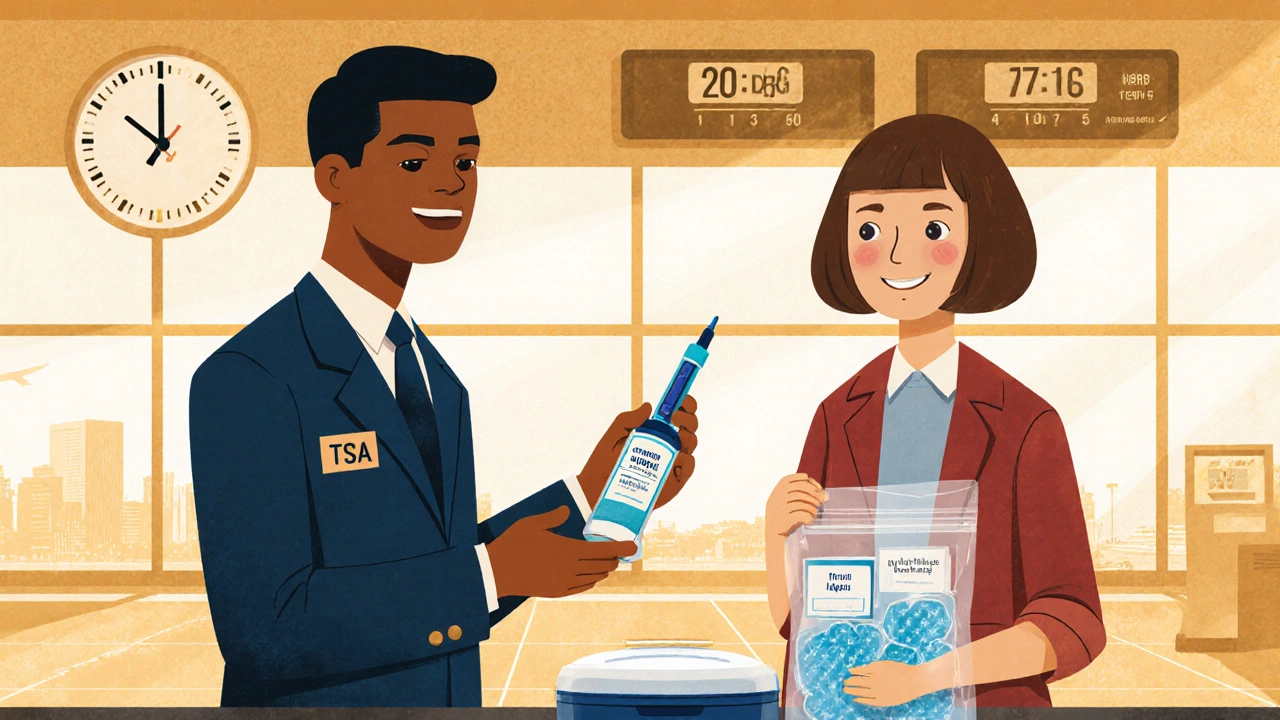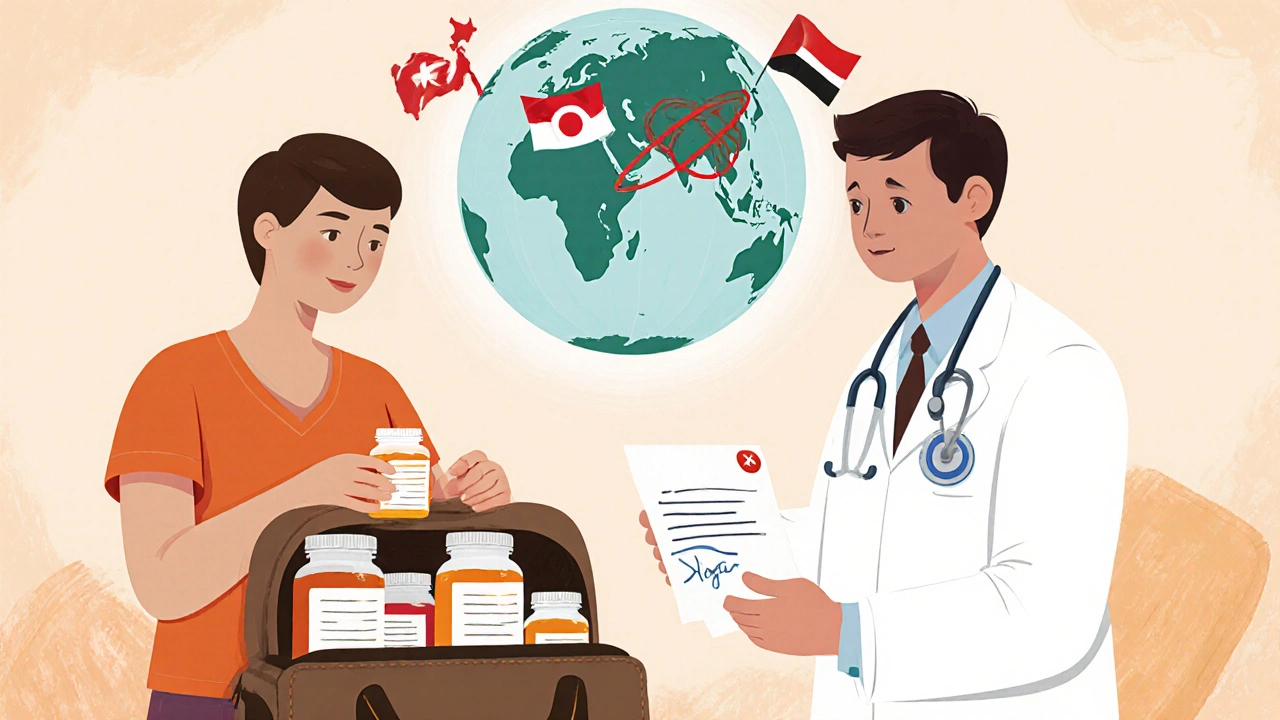Traveling with Medications Isn’t Just About Packing Pills
Half of all American adults take prescription meds daily. If you’re one of them, and you’re planning a trip, you’re not just packing clothes and chargers-you’re packing your health. Forget the idea that bringing your meds is simple. One wrong move-like carrying a bottle without a label, or bringing a common OTC pill into the wrong country-and you could face detention, fines, or worse. This isn’t fear-mongering. It’s fact. In 2019, a Toyota executive spent 23 days in a Japanese jail because she mailed herself a painkiller that’s legal in the U.S. but banned in Japan. She didn’t know it was illegal. You won’t make that mistake after this.
Always Keep Meds in Original Containers
Don’t dump your pills into a pill organizer before you leave. Even if it’s convenient, TSA and customs officials require medications to be in their original pharmacy bottles with clear labels. That means the name of the drug, your name, the prescriber’s info, and the pharmacy’s stamp must all be visible. Why? Because fake prescriptions are a real problem. If your bottle says "Amoxicillin 500mg" but the label doesn’t match your name or the pharmacy’s contact info, you’re asking for trouble. This rule applies whether you’re flying from Boston to Miami or from Toronto to Tokyo.
For liquid meds-like insulin, asthma inhalers, or liquid pain relievers-TSA lets you bring more than 3.4 ounces, but you must declare them at security. Put them in a separate clear plastic bag, just like your toiletries. Don’t hide them. Don’t assume you’ll get a pass because you’re sick. Declare them. Show them. Let the agent see you’re not hiding anything. It takes 30 seconds. It saves you hours.
Bring More Than Enough-Plus a Buffer
Plan for delays. Flights get canceled. Borders close. You might get sick and need to extend your stay. That’s why experts recommend bringing at least 7 to 14 extra days’ worth of medication on top of what you need for your trip. Northwestern University’s travel safety team says: "Three weeks before departure, confirm you have enough to cover your entire trip plus two weeks."
Insurance won’t cover refills overseas. Overseas pharmacies won’t refill your U.S. prescription. If you run out, you’re stuck. Some countries won’t even sell you the same drug without a local prescription-something you can’t get without a local doctor. And if your meds are controlled substances (like Adderall, Xanax, or codeine), you’re in a whole different zone. Many countries treat them like illegal drugs. Bring extra. Always.
Check Every Country’s Rules-Not Just One
You think you know what’s allowed? You don’t. The U.S. State Department found that 67% of countries restrict at least one common U.S. medication. Sudafed? Banned in 28 countries because it contains pseudoephedrine. Adderall? Illegal in Japan, Singapore, and the UAE. Birth control pills? Restricted in Saudi Arabia. Codeine? Prohibited in over 40 countries, including Thailand and South Korea.
Don’t guess. Don’t rely on a friend’s old trip. Go to the U.S. embassy website for your destination. Use the State Department’s Medication Check Tool (launched March 2023). Type in your medication name-exactly as it appears on the bottle-and it tells you if it’s legal, restricted, or banned. Do this for every country you’ll visit, even if you’re just transiting. A layover in Dubai means you’re subject to UAE rules. A stopover in Seoul means you’re under South Korea’s laws.
Get a Doctor’s Letter-Especially for Injectables and Controlled Substances
If you use insulin, epinephrine pens, or anything that looks like a drug you’d see in a spy movie, you need a letter from your doctor. Not a note. Not a prescription copy. A letter on official letterhead that says:
- Your full name and date of birth
- Your diagnosis (e.g., Type 1 diabetes, severe allergies)
- Each medication name, dosage, and frequency
- That the medication is medically necessary
- The doctor’s license number, contact info, and signature
This isn’t optional for controlled substances. If you’re flying Emirates and carrying codeine, they’ll ask for this before you board. If you’re entering Japan with ADHD meds, customs will hold you until they verify it. A doctor’s letter cuts through the red tape. Get it at least a week before you leave. Pharmacies can’t write these. Only your doctor can.

Temperature Matters More Than You Think
Insulin doesn’t just go bad if it’s left in a hot car. It can lose potency in minutes under direct sun. Most pills are fine at room temperature, but if you’re heading to a tropical destination-think Bali, Bangkok, or the Caribbean-your meds can degrade if they’re packed in checked luggage where temps hit 100°F+.
Keep all meds in your carry-on. Always. Checked bags go through uncontrolled cargo holds. The CDC says 22% of medication complaints from travelers involve heat damage. Insulin? Must stay between 36°F and 46°F (2°C-8°C). Use a small insulated travel cooler with a reusable gel pack. You can buy pharmaceutical-grade ones online for under $20. They last 48+ hours. For other meds, avoid direct sunlight. Store them in your hotel room safe, not the minibar. If you’re flying, keep them in your backpack or purse-not in the overhead bin.
Time Zones Will Mess With Your Schedule
When you cross time zones, your body doesn’t reset instantly. Taking your blood pressure pill at 8 a.m. your time? That might be 10 p.m. back home. Doubling up doses to "catch up" is dangerous. Missing a dose? That’s risky too.
WebMD’s advice is simple: It’s usually safe to take your meds 1-2 hours earlier or later than usual. Don’t skip. Don’t double. Use your phone. Set two alarms: one for your home time zone and one for the local time. Apps like Medisafe Travel let you program your med schedule and alert you based on local time. They even show you if you’re taking a med at the wrong time based on your destination. 81% of travelers who use this method say they never miss a dose.
What If You Lose Your Meds?
Lost luggage? Theft? Spilled pills? Have a backup plan. First: always carry all your meds in your carry-on. That’s non-negotiable. Second: keep a digital copy of your prescriptions and doctor’s letter on your phone and in the cloud. Third: know where to get help. Most major U.S. embassies have a list of local pharmacies and doctors who can help in emergencies. Call them before you need them.
If you’re in a pinch and need a refill, your doctor can sometimes call in a prescription to a local pharmacy if you’re in a country with reciprocal agreements. But that’s rare. Better to be prepared. Pack a small ziplock with a few extra doses of your most critical meds-just in case. And if you take insulin, carry a spare pen and a few extra needles. Always.
Side Effects Don’t Take a Vacation
Travel changes your body. Jet lag. Different food. Stress. Alcohol. All of it can make side effects worse. Diarrhea from antibiotics? Dehydration hits harder on a plane. Dizziness from blood pressure meds? That’s dangerous when you’re navigating a foreign train station.
Know your meds. Read the side effect sheet. If you feel off-headache, nausea, rash, confusion-don’t assume it’s just jet lag. It might be your med reacting to something new. Keep a small notebook or phone note listing your meds and what side effects to watch for. If you’re traveling with someone, tell them what to look for. If you’re alone, set a daily check-in with a friend or family member back home.

Use a Travel Med Kit-But Make It Smart
Don’t just toss everything into a bag. Build a travel med kit. Use a small, clear, waterproof case. Inside: all meds in original bottles, doctor’s letter, digital copies, extra doses, cooling pack, hand sanitizer, and a printed list of your meds with dosages. Add a laminated card with your meds in English and the local language. Google Translate can help you print it. For example: "Insulin 10 units twice daily" in Spanish: "Insulina 10 unidades dos veces al día."
74% of travelers who use multi-dose packaging (like those from CVS or Walgreens) say they’re less stressed. Ask your pharmacy to put your week’s meds into daily blister packs. It’s free. It’s organized. It’s foolproof.
What You Shouldn’t Do
- Don’t ship meds to yourself overseas. It’s illegal in most countries and will get confiscated.
- Don’t take someone else’s meds-even if they have the same condition.
- Don’t assume your travel insurance covers medication emergencies. Most don’t.
- Don’t forget to pack your OTC meds: pain relievers, antihistamines, anti-diarrheal, and antacids. You might not find the same brands abroad.
- Don’t wait until the last minute. Start planning two weeks before departure. For international trips, start three weeks out.
Frequently Asked Questions
Can I bring my insulin on a plane?
Yes. Insulin is allowed in carry-on luggage in any quantity, even if it’s in liquid form. Keep it in its original packaging with the pharmacy label. Declare it at security. Use a cooling pack to keep it between 36°F and 46°F. Never check insulin in your luggage.
Are over-the-counter meds like Advil or Sudafed allowed abroad?
Some are, some aren’t. Advil (ibuprofen) is fine almost everywhere. Sudafed (pseudoephedrine) is banned in 28 countries, including Japan and Singapore. Always check the U.S. State Department’s Medication Check Tool before you pack anything-even if it’s sold freely at CVS.
What if I need a refill while overseas?
You can’t refill a U.S. prescription overseas. Overseas pharmacies don’t recognize them. Your best bet is to bring extra. If you run out, contact your country’s embassy. They may have a list of local doctors who can prescribe a replacement. But don’t count on it. Prevention is the only reliable strategy.
Can I bring my vape or nicotine patch on a flight?
Nicotine patches are allowed in carry-on luggage. Vapes and e-cigarettes are also allowed, but only in carry-on-you can’t check them. Batteries must be protected from short-circuiting. Some countries ban vapes entirely (like Thailand and Singapore), so check local laws before you go.
Do I need to declare my meds at customs?
You’re not always required to declare them, but you must be prepared to show them if asked. Keep your meds in original bottles with labels. Carry your doctor’s letter. If you’re unsure about a country’s rules, declare them anyway. It’s better to be transparent than to risk being accused of smuggling.
Next Steps: Your 3-Week Travel Med Plan
- Week 3 before departure: Call your doctor. Ask for a letter and enough refills to cover your trip plus two weeks. Confirm your pharmacy can fill it early.
- Week 2: Use the U.S. State Department’s Medication Check Tool. Verify every medication you’re bringing for every country you’ll visit.
- Week 1: Pack your med kit. Use original bottles. Add cooling packs if needed. Print copies of your letter and prescriptions. Set phone alarms for time zones. Tell someone your med schedule.
Traveling with meds isn’t about being paranoid. It’s about being prepared. The system works if you follow the rules. Don’t let ignorance turn your dream trip into a nightmare.

Gavin McMurdo
October 29, 2025 AT 00:42Jesse Weinberger
October 29, 2025 AT 04:50Emilie Bronsard
October 30, 2025 AT 13:39John Bob
November 1, 2025 AT 06:33Alex Grizzell
November 2, 2025 AT 11:26George Johnson
November 2, 2025 AT 18:25Rodrigo Ferguson
November 4, 2025 AT 04:19Mickey Murray
November 5, 2025 AT 09:56Kevin McAllister
November 6, 2025 AT 14:21